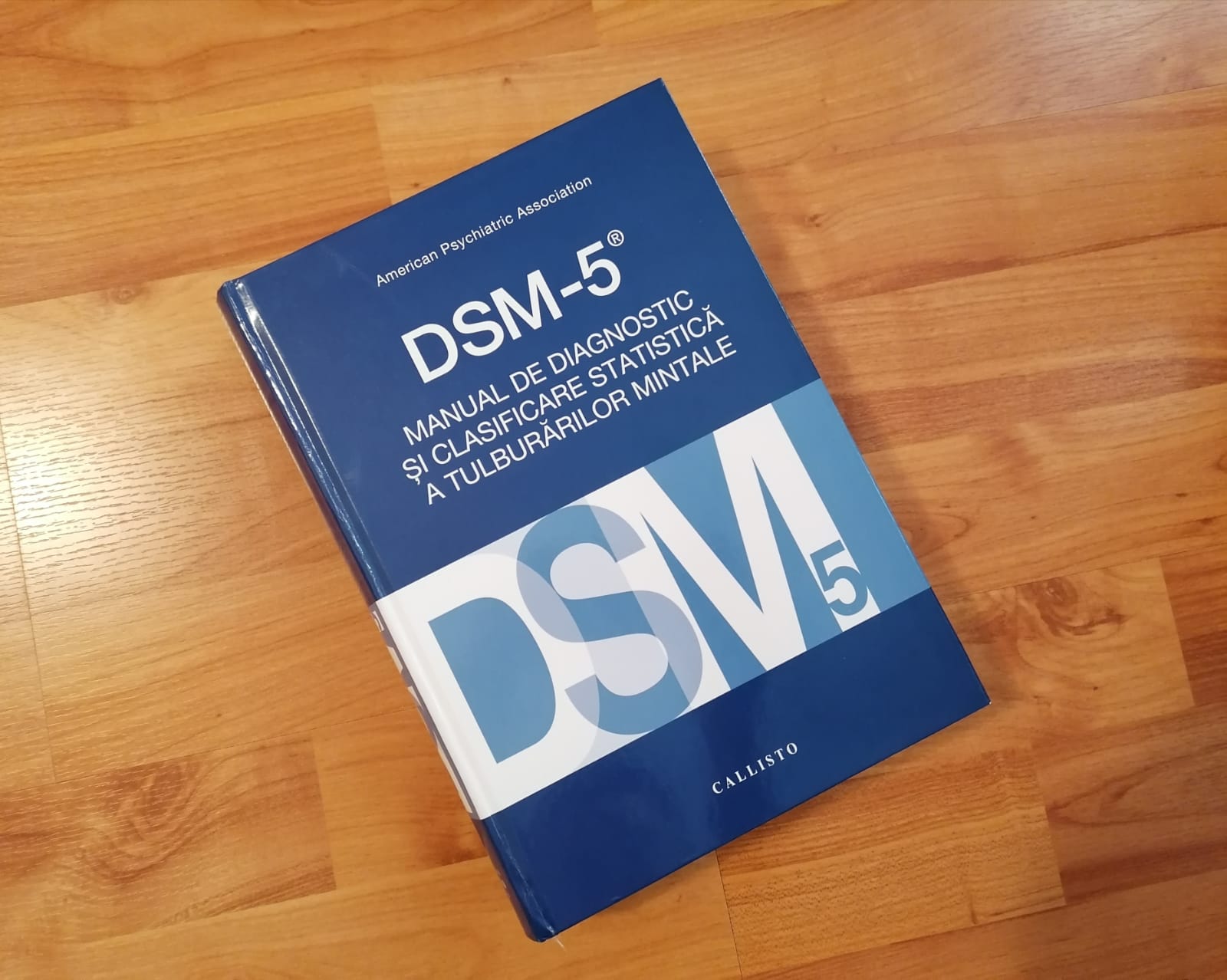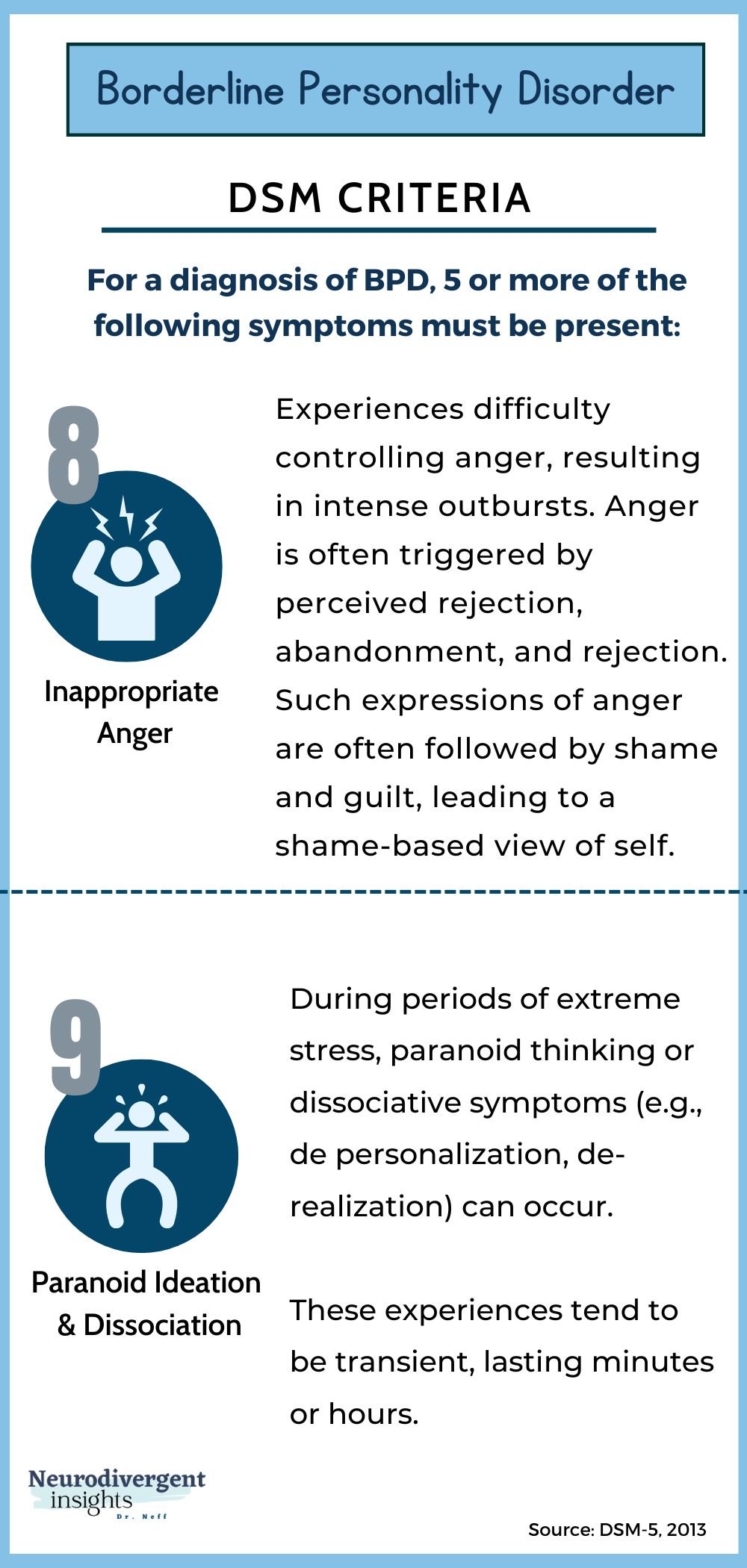
Borderline Personality Disorder (DSM 5) Unillustrated Adventures
Borderline personality disorder is characterized by a pervasive pattern of instability and hypersensitivity in interpersonal relationships, instability in self-image, extreme mood fluctuations, and impulsivity. Diagnosis is by clinical criteria. Treatment is with psychotherapy and sometimes medications.

(PDF) The role of DSM5 borderline personality symptomatology and traits in the link between
The Diagnostic and Statistical Manual of Mental Disorders, 5th edition (DSM-5) lists ten personality disorders divided into the 3 clusters (A, B, and C). [1] Borderline personality disorder (BPD) is 1 of 4 cluster-B disorders that include borderline, antisocial, narcissistic, and histrionic.

Borderline Personality Disorder Traits Dsm 5 Who Im I
According to the DSM- 5, to diagnose a borderline personality disorder, the following criteria must be met: A. Significant impairments in personality functioning manifest by: Impairments in self-functioning (a or b):. 1. Identity:. Markedly impoverished, poorly developed, or unstable self-image, often associated with excessive self-criticism; chronic feelings of emptiness; dissociative states.

Tulburarea de personalitate borderline DSM5 Manual de Diagnostic și Clasificare Statistică a
Borderline personality disorder is a mental health disorder that impacts the way you think and feel about yourself and others, causing problems functioning in everyday life. It includes self-image issues, difficulty managing emotions and behavior, and a pattern of unstable relationships.

Table 6 from DSM5 Criteria for Borderline Personality Disordera Semantic Scholar
One of the least highlighted changes in the DSM-5 is the modification of the classification of borderline intellectual functioning. 1 Contrary to earlier DSM versions, IQ boundaries are no longer part of the classification, leaving the concept without a clear definition. IQ scores are, over most of the range, well described by a normal distribution.

Table 1 from DSM5 Criteria for Borderline Personality Disordera Semantic Scholar
DSM-5 Criteria for Borderline Personality Disorder The DSM-5 outlines nine key criteria for BPD, and a diagnosis typically requires that an individual exhibits at least five of these symptoms: Frantic Efforts to Avoid Abandonment: This includes both real and imagined scenarios of abandonment.

[PDF] DSM5 Criteria for Borderline Personality Disordera Semantic Scholar
of DSM-IV-TR criteria, prevalence rates for borderline personality disorder, and general infor-mation on its natural history and course. Section VI is a structured review and synthesis of pub-. Borderline personality disorder is the most common personality disorder in clinical settings, and it is present in cultures around the world. However.

Dsm 5 Criteria For Borderline Personality Disorder Pdf Who Im I
Borderline personality disorder (BPD) is one type of personality disorder recognized in the Diagnostic and Statistical Manual of Mental Disorders (DSM-5-TR). Like other conditions, borderline personality disorder has its own specific set of diagnostic criteria in the DSM.

DSM5 Criteria for Borderline Personality Disorder — Insights of a Neurodivergent Clinician (2022)
There are nine symptoms associated with BPD, according to the DSM-5. You have to have five or more of the following symptoms to be diagnosed with borderline personality disorder: frantic.

Table 1 from DSM5 Criteria for Borderline Personality Disordera Semantic Scholar
Table 2 lists the diagnostic criteria for borderline personality disorder as outlined in the Diagnostic and Statistical Manual of Mental Disorders, 5th ed. (DSM-5). 14 The clinical diagnosis.

The Overall Approach of the Dsm5 Is Best Described as
DSM-5 diagnostic criteria for BPD^ A pervasive pattern of instability of interpersonal relationships, self-image and affects, and marked impulsivity beginning by early adulthood and present in a variety of contexts, as indicated by five (or more) or the following:. The Borderline pattern descriptor may be applied to individuals whose pattern.

New Light on Borderline Personality Disorder (BPD) in DSM5TR and ICD11 (Conference) YouTube
The validity of the current criteria for borderline personality disorder shares problems with other psychiatric disorders: namely, the absence of biological markers, unclear delimitation from other disorders, and a wide variety of combinations of symptoms that could lead to heterogeneity.

(PDF) DSM5 Borderline Personality Disorder At the Border Between a Dimensional and a
Borderline personality disorder is a mental illness that severely impacts a person's ability to regulate their emotions. This loss of emotional control can increase impulsivity, affect how a person feels about themselves, and negatively impact their relationships with others.

Borderline Personality Disorder Impact, Overlap, and Comorbidities
Borderline personality disorder is a mental illness that severely impacts a person's ability to manage their emotions. This loss of emotional control can increase impulsivity, affect how a person feels about themselves, and negatively impact their relationships with others.
Borderline Personality Disorder Dsm 5 Pdf Who Im I
According to the DSM-5, individuals with BPD exhibit some or all of the following symptoms: Efforts to avoid real or imagined abandonment. Intense bouts of anger, depression, or anxiety that.

Table 2 from Continuity between DSM5 Categorical Criteria and Traits Criteria for Borderline
Dialectical behavior therapy (DBT). DBT includes group and individual therapy designed specifically to treat borderline personality disorder. DBT uses a skills-based approach to teach you how to manage your emotions, tolerate distress and improve relationships. Schema-focused therapy. Schema-focused therapy can be done individually or in a group.